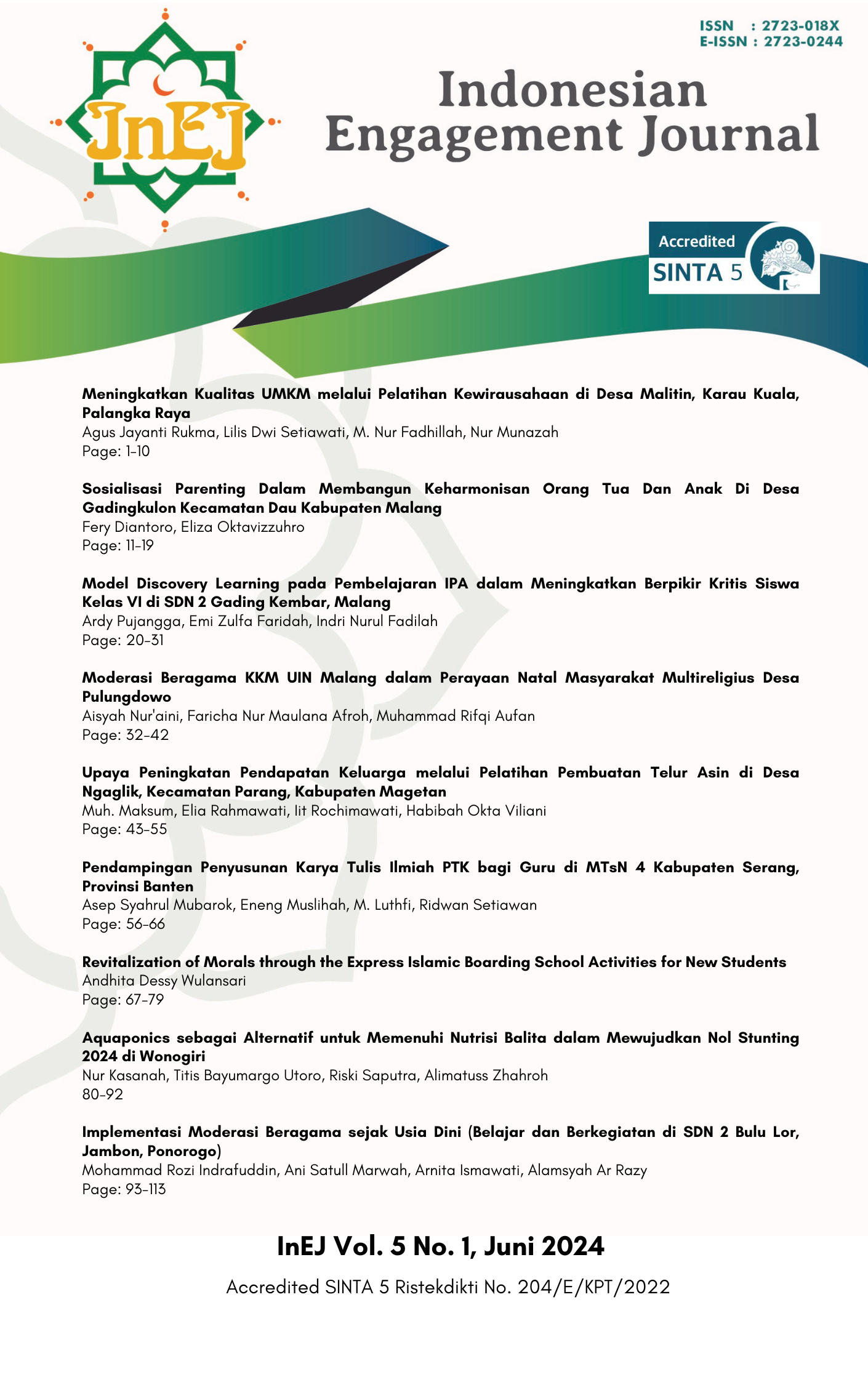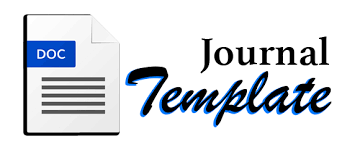AQUAPONICS AS AN ALTERNATIVE TO FULFIL TODDLER NUTRITION TO REALISE 2024 ZERO STUNTING IN WONOGIRI
DOI:
https://doi.org/10.21154/inej.v5i1.8611Keywords:
Aquaponics, Nutrition, Stunting, ToddlerAbstract
Aquaponics can be an innovative alternative in fulfilling nutrition for stunted toddlers. The aquaponics system simultaneously integrates fish farming and plant growth, producing nutrient-rich agricultural products and providing fish protein. This community service activity aims to meet the nutritional intake of toddlers indicated to be stunted in Bangsri Village, Purwantoro District, Wonogiri Regency while supporting the efforts of the Wonogiri Regency Government to realize the 2024 Zero Stunting program. The service method chosen is asset-based community development (ABCD), which consists of inculturation, discovery, design, definition, and reflection activities. Data were collected through interviews, observation, and documentation. The results showed that stunting is not a representation of poverty. Stunted toddlers also exist in well-off families. From the education, facilitation, and assistance of aquaponics in families with stunted toddlers for 30 days, healthy and pesticide-free catfish and water spinach vegetables can be harvested as a source of nutrition and animal protein for stunted toddlers. It proves aquaponics positively affects the nutrition of stunted children and supports the 2024 Zero Stunting program in Wonogiri.
References
Al-Kautsari, M. M. (2019). Asset-Based Community Development : Strategi Pengembangan Masyarakat. Empower: Jurnal Pengembangan Masyarakat Islam, 4(2), 259. https://doi.org/10.24235/empower.v4i2.4572
Beal, T., Tumilowicz, A., Sutrisna, A., Izwardy, D., & Neufeld, L. M. (2018). A review of child stunting determinants in Indonesia. Maternal & Child Nutrition, 14(4), e12617.
Hamer, W., Maliki, B. B., & Mapruhah, A. (2022). Meningkatkan Kesadaran Masyarakat akan Pentingnya Pemenuhan Gizi dalam mencegah stunting di Desa Sukamaju Kecamatan Labuan Kabupaten Pandeglang. Jurnal Penyuluhan Dan Pemberdayaan Masyarakat, 1(2), 14”“20.
Hidayat, R. (2022). Prevalensi Stunting Pada 1000 Hari Pertama Kehidupan. Journal Of Baja Health Science, 2(01), 61”“77.
kemenkes.goid. (2023). Prevalensi Stunting di Indonesia Turun ke 21,6% dari 24,4%. https://www.kemkes.go.id/id/rilis-kesehatan/prevalensi-stunting-di-indonesia-turun-ke-216-dari-244
LPPM IAIN Ponorogo. (2023). Pedoman Kuliah Pengabdian Masyarakat Tahun 2022. LPPM IAIN Ponorogo.
Martony, O. (2023). Stunting di Indonesia: Tantangan dan Solusi di Era Modern. Journal of Telenursing (JOTING), 5(2), 1734”“1745.
Peraturan Presiden Nomor 72 Tahun 2021 tentang Percepatan Penurunan Stunting.
Praditia, M. D. (2023). Manyaran Masuk, Ini 5 Kecamatan dengan Kasus Stunting Terbanyak di Wonogiri. https://soloraya.solopos.com/manyaran-masuk-ini-5-kecamatan-dengan-kasus-stunting-terbanyak-di-wonogiri-1770426
Septiana, A. F., Hendrawan, A. W. P., Nadirawati, A. B., Salsabila, F. Y., Ningsih, F., Indriani, H., Amiq, M. F., Rosyidin, R. F., Annisa, R. S., & Dewi, S. A. (2023). Aksi Cegah Stunting melalui Program Keluarga Binaan di Desa Darsono Kecamatan Arjasa. Jurnal IDAMAN (Induk Pemberdayaan Masyarakat Pedesaan), 7(2), 163”“170.
Sinaga, M., Tira, D. S., & Regaletha, T. A. L. (2022). Edukasi Pentingnya Pemenuhan Gizi pada 1000 HPK dalam Upaya Pencegahan Stunting. Jurnal Pengabdian Pada Masyarakat Kepulauan Lahan Kering, 3(2), 72”“81.
stunting.go.id. (2022). Target 2024 Zero Stunting, Bupati Wonogiri Petakan Kasus untuk Percepat Penanganan. https://stunting.go.id/target-2024-zero-stunting-bupati-wonogiri-petakan-kasus-untuk-percepat-penanganan/
TP2AK, T. P. P. A. K. (Stunting). (2020). Peta Jalan Percepatan Pencegahan Stunting Indonesia 2018-2024. Kementerian Sekretariat Negara RI.
Downloads
Published
Issue
Section
License
Please find the rights and licenses in InEJ. By submitting the article/manuscript of the article, the author(s) agree with this policy. No specific document sign-off is required.1. License
The non-commercial use of the article will be governed by the Creative Commons Attribution license as currently displayed on Creative Commons Attribution-NonCommercial-ShareAlike 4.0 International License.
2. Author(s)' Warranties
The author warrants that the article is original, written by stated author(s), has not been published before, contains no unlawful statements, does not infringe the rights of others, is subject to copyright that is vested exclusively in the author and free of any third party rights, and that any necessary written permissions to quote from other sources have been obtained by the author(s).
3. User/Public Rights
The spirit of InEJ is to disseminate articles published are as free as possible. Under the Creative Commons license, InEJ permits users to copy, distribute, display, and perform the work for non-commercial purposes only. Users will also need to attribute authors and InEJ on distributing works in the journal and other media of publications. Unless otherwise stated, the authors are public entities as soon as their articles got published.
4. Rights of Authors
Authors retain all their rights to the published works, such as (but not limited to) the following rights;
Copyright and other proprietary rights relating to the article, such as patent rights,
The right to use the substance of the article in own future works, including lectures and books,
The right to reproduce the article for own purposes,
The right to self-archive the article,
The right to enter into separate, additional contractual arrangements for the non-exclusive distribution of the article's published version (e.g., post it to an institutional repository or publish it in a book), with an acknowledgment of its initial publication in this journal (InEJ: Indonesian Engagement Journal).
5. Co-Authorship
If the article was jointly prepared by more than one author, any authors submitting the manuscript warrants that he/she has been authorized by all co-authors to be agreed on this copyright and license notice (agreement) on their behalf, and agrees to inform his/her co-authors of the terms of this policy. InEJ will not be held liable for anything that may arise due to the author(s) internal dispute. InEJ will only communicate with the corresponding author.
6. Royalties
Being an open accessed journal and disseminating articles for free under the Creative Commons license term mentioned, author(s) aware that InEJ entitles the author(s) to no royalties or other fees.
7. Miscellaneous
InEJ will publish the article (or have it published) in the journal if the article’s editorial process is successfully completed. The editors of Journal may modify the article to a style of punctuation, spelling, capitalization, referencing and usage that deems appropriate. The author acknowledges that the article may be published so that it will be publicly accessible and such access will be free of charge for the readers as mentioned in point 3.




